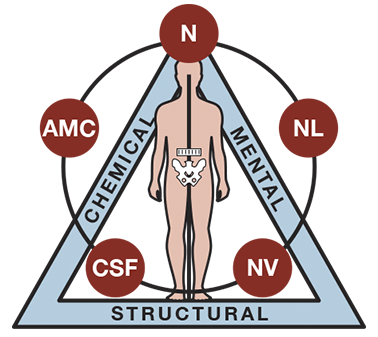Solve Root Systemic Causes—Thoughts, Trauma, and Toxins

“We must treat the person’s ENTIRE BEING.
You can’t be healthy in one area and not another. You are the same person everywhere, with everyone, and at every time.”
– Dr. Ben
AK is a non-invasive system of evaluating body function that is unique in the healing arts, has become a dynamic movement in health care in its relatively short existence.
The combined terms “applied” and “kinesiology” describe the basis of this system, which is the use of manual muscle testing to evaluate body function through the dynamics of the musculoskeletal system.
Treatments may involve specific joint manipulation or mobilization, various myofascial therapies, cranial techniques, meridian and acupuncture skills, clinical nutrition, dietary management, counseling skills, evaluating environmental irritants and various reflex procedures.
Info from: https://www.icakusa.com/what-is-ak
The QA Clinical Protocol asserts that the most “elegant” use of the MMT response is as a somatic window on neurological function; a measurement of the collective influences (inhibition and excitation) on the anterior horn motor neuron (AHMN) pool of the muscle being tested.
Literally, all health problems, whether functional or pathological, are involved with one part or all parts of the triad.
This is not new to chiropractic, as its founder, D.D. Palmer states in his text, The Science, Art, and Philosophy of Chiropractic, “The determining causes of disease are trauma, thoughts & toxins.”
AK enables the doctor to evaluate the triad’s functional balance and direct therapy toward the imbalanced side or sides.
The physician who is aware of the triad of health, and evaluates every patient for all three sides, increases his ability to find the basic underlying cause of a patient’s health problem.
AK skills are developed and approved by the International College of Applied Kinesiology (ICAK) Board of Standards.

Patients who walk through the door of any clinician / physician’s office has this thought, “I hope the doctor can figure out what’s wrong with me and fix it once and for all.”
On the other side of the consultation room, physicians and clinicians are confronted daily with recurring and provocative questions precipitated by perplexing patient presentations:
When not carefully thought through, treatment might merely end up as relief of a local symptom.
Common medical practices including some natural healthcare providers often look at the patient’s local complaint(s) as the primary focus of the initial clinical assessment.
– Dr. Walter Schmitt, DIBAK, DABCN
The holistic health approach for ANY health problem should be answering this question: “What comes first, next and last?”
This means there is a pre-set hierarchy by which your health abides… ”something happens first before something else happens next…”
A very fundamental principle to understand for doctor/patient:
Since all systems: immune, endocrine, gut, muscular, etc. are adversely impacted by nociception or pain…shouldn’t we address nociceptive activity prior to addressing any other system or local problem?
– Dr. Walter Schmitt, DIBAK, DABCN
Info from: https://qahomestudy.com/what-is-qa/
Firstly, let’s define pain…
The International Association for the Study of Pain (IASP) defines pain as an unpleasant sensory and emotional experience associated with, or resembling that associated with, actual or potential tissue damage… read more >
Pain, when first felt, if not too severe, is merely a ‘sensation’ perceived by your brain. You recognize it, locate it, and then you don’t think much about it thereafter.
However, when pain is severe and prolonged enough, it starts to affect memory, emotions, hormones etc.
When pain starts to affect your other body systems as mentioned above, your health issues are no longer just localized. In fact, your problems are now systemic (and local).
Existence of systemic problems cause local problem treatment to be less effective, if at all.
The fundamental premise of a neurologically driven, top-down-inside-out thought process, illuminates the fact that one must first address systemic influences prior to addressing local problems – this pivotal principle provides powerful possibilities for predictable, consistent and lasting outcomes.
BOTTOM LINE is this: There is a logical “path to follow so that the outcome of treatment is most harmonious with the patient’s physiology.
The following group of health challenges form the majority of the diagnosable medical conditions we see today.


We intentionally make time to listen, give counsel, and use evidence-based holistic health methods to uncover and treat EVERY root cause of disease.
Chirogenesis
79 Anson Rd
#22-01
Singapore 079906
Mobile: +65 81294204
Email: enquiry@chirogenesis.org
Site Developed by Healthy Chiropractice
Copyright © 2023. All rights reserved. | Privacy Policy